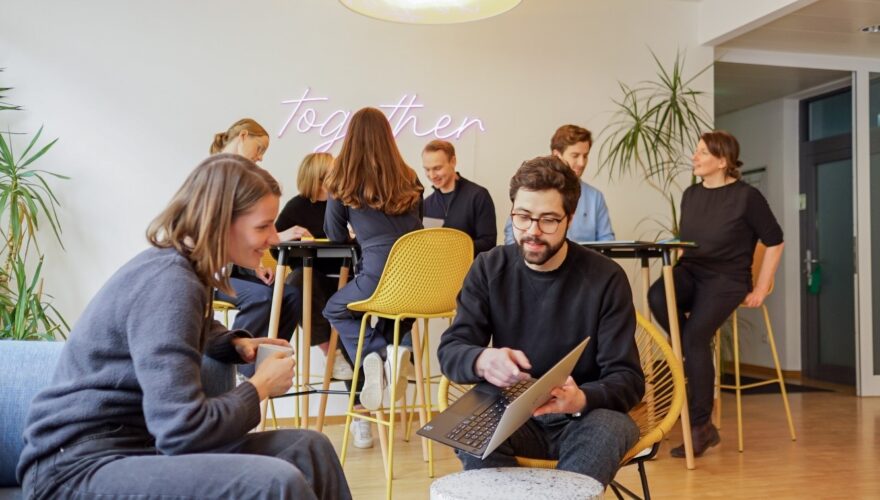How to change a corporate innovation culture through idea campaigns – JTI’s hunt for the next great idea

Crowdsourcing is decision making
Within every organization, employees are constantly generating brilliant ideas that have the potential to deliver groundbreaking results. Unfortunately, most of these ideas are never capitalized on because the company is not using an adequate process or tool. An internal idea campaign can serve as such.
If employees are not being involved in the decision-making process, companies are missing out on an opportunity to make them feel involved, heard, and respected. This is especially true for crowdsourcing predictions: When you give employees a stake in decisions that directly impact them, they’ll be more invested in your company as a whole.
Clients often have cool ideas about a product or service, but they can also be highly biased or not fully informed. On the other hand, employees have the kind of collective wisdom and experience that consumers simply cannot bring to the table. Plus, employees will be the ones implementing the ideas — they’ll likely skip the “pie in the sky” concepts and face-2-face feedback is possible at any time.

Community-based innovation – when and how?
Current trends strengthen the importance of community-based Innovation and community solutions can be applied along the entire innovation management process (insights, ideation, enrichment, testing, etc.).
There is no one- size fits all toolkit, rather different types of community approaches (Internal Campaigns, Online Research Communities, crowd-sourcing) can be value-adds to the innovation process. As knowledge-sharing platforms and contests can help to break silos and support the shift towards an innovation mindset, tools or platforms should be easily accessible for employees.
It is essential to navigate between central and decentralized approaches to allow for synergies, a level of expertise & freedom across countries and units & ensure an interplay of the right KPIs, IPs, and project budgeting to foster community-based innovations.
JTI’s challenge
JTI, Japan Tobacco International, is the international tobacco and vaping division of Japan Tobacco Inc, a leading tobacco company in Japan with its (amongst other) well-known brands Winston, Mevius, Camel, and LD. Today, more than 45,000 employees are driving JTI’s success all over the world. JTI’s mission is to nurture its internationally recognized brand roster while leading the way in reduced-risk products and new ways of doing business.
In 2020 JTI kicked off its first global idea campaign together with HYVE. JTI’s goal was not only to collect a high number of ideas and develop new concepts but also to test whether it was possible to potentially reach all 45.000 employees and get them involved in this campaign. (Let us sneak-peak: it worked out!)
To manage such a massive idea-potential and human power, the project was set up as an all-inclusive package. HYVE’s project team drew itself responsible for all communication actions upfront the campaign, for community management and the evaluation rounds after the idea campaign. HYVE’s approach was to work in a very agile way, allowing quick adjustments or even changes to the project processes, whenever needed. For this purpose, the project team worked in different task forces in the areas of design, communication, and community management.
We talked with Mark Aspinall-Paul (Innovation Manager at JTI) for our podcast series The Secret Source of Innovation. Find out, how he introduces JTI and assesses the innovative strength of his colleagues worldwide. Click here to listen to the episode.
HYVE’s four main phases to a successful global ideation campaign
Kick-off & topic framing
The aim of the kick-off was not only to gain a deeper understanding of JTI’s identified topic but also to ensure the alignment of the core team on the scope, relevant stakeholders, goals and expected outcome of the campaign.
Setup and preparation
Within the determined frame, a concise question needed to be developed. Building on this, both the platform itself and the content on and around it had to be prepared to provide a suitable environment and infrastructure for the campaign and its promotion.
Campaign Management
Once the campaign and its related content were prepared and set up, the campaign started. Besides continuous communications updates, it was important to involve relevant stakeholders, proactively motivate and support campaign participation during its entire runtime.
Evaluation & Elaboration
After the campaign ended, the next phase focused on turning ideas into products and services started. The most promising submissions were evaluated and shortlisted for further elaboration. Finally, a jury evaluated and decided on the winning idea(s).
A flexible project management enabled a fast execution of overnight and varying requests. Due to the different teams (communication, community management, project management, etc.), it was well possible to work on the different project phases (partly) in parallel. Each project team had a sub-project manager who was responsible for the team and reporting. In this way, we were able to synchronize and monitor each other in a weekly meeting.
Rafael Gerber, Innovation expert at HYVE Switzerland

Communication is key – how we got corporate-wide attention
Communication about the Global Idea Hunt was distributed on several channels at JTI to make sure, it got the highest attention possible. A multi-channel and cross-functional, global, and engaging communication led to a great reach. The following measures led to a perfect reach:
1. Ambassador Program: To support the campaign in the local JTI markets, an Ambassador Program – probably the largest component in the project – was set up to foster the maximum reach. Local ambassadors know the local culture and people best, so in each market, at least one ambassador was chosen, who was then responsible for the success in this market. The ambassadors, therefore, had an important role in the project and were also briefed weekly by the project team and fed with new information in a weekly call.
2. Workplace: an internal company communication tool at JTI. A channel was set up on Workplace specifically for the campaign. Within a few hours, the channel had over 1,000 members and over 2,000 by the end of the online phase, so we were able to communicate quickly and efficiently via Workplace in a campaign-specific way without sending too many emails. In addition, these posts could be shared locally by our ambassadors in their groups, and some ambassadors even ran their own campaigns.
3. Business TV: There are business TVs in many JTI offices, cafeterias, and hallways. These run any internal news, updates, teasers, etc. throughout the day. We have prepared some good video teasers for the campaign (editable for translation into the different local languages) and ensured, that also employees without their own notebook knew about the Global Idea Hunt.
4. Email / Notifications: We deliberately refrained from communicating via email. After a one-time leek notification of the online phase, only emails were sent via the platform (e.g. when an idea was submitted or the own idea received a comment or a thumbs up). However, these settings could be set individually by the idea providers and could also be switched off completely.
Great people with great ideas – the outcome
Within only six weeks 6800 participants (15% of all employees) from over 80 markets worldwide submitted over 2200 ideas to revolutionize JTI’s products and packaging for Ready Made Cigarettes and Fine Cut Tobacco while keeping JTI’s four Focus Areas in mind (Considerate Smoking, Taste & Flavors, Value for Money, Sustainability).
127.000-page visits and 8679 comments show the great reach and engagement of JTI’s employees.

In the end, it is all about the people. It needs visionary leaders that live the cultural change from the top as well as formats that empower employees to drive innovation from the bottom (grass-root movements, ambassadors). We took a risk and tried it that way, and it proved to be a huge success.
Mark Aspinall-Paul, Innovation Manager at JTI
Take-Aways for your next idea campaign
- Identify AND incorporate trends by partnering up, connecting units, and getting the upper management on board. Use existing structures, and local marketing power, engage locally for stronger results.
- To drive cultural change through internal innovation initiatives it needs visionary leadership, the involvement of middle management, and the empowerment of employees/ grass-root movements.
- Communication is key: to involve every employee, make sure they all know about the campaign. Make communication and participation accessible to everyone, start early, send reminders, keep engaged.
- Depending on the challenge and innovation scope teams need the time and space to be lean, agile, and creative. Give feedback, manage the community by commenting, and keep your community close to the process.
- Break the silos through guided idea management & collaborative contest and community platforms. Provide smart incentives for participation (different countries, different incentives, quality before quantity).
- Failure tolerance is necessary so that people are not afraid or restricted to contribute with new, innovative ideas. Build trust.
- Navigate between central and decentralized approaches to allow for synergies, a level of expertise & freedom across countries and units.
- Integrate community-based innovation approaches at any step of your innovation management journey (insights, ideation, enrichment, testing, etc.).
- Provide a set of tools / best practices that guide employees through the internal contest while keeping company-specific challenges in mind.
- There is no one- size fits all toolkit, rather different types of community approaches (Internal Campaigns, Online Research Communities, crowdsourcing) can be value-adds to the innovation process.
Internal crowdsourcing offers a real return on investment, but more than that, it’s a chance to transform the way you do business — for the better. You’ll lower your risk of failure on major initiatives while increasing retention and morale.

